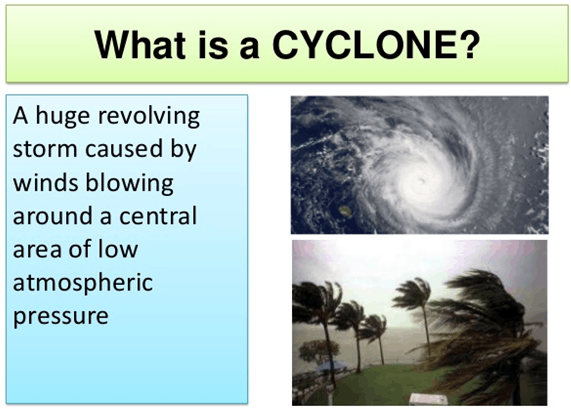ALSO WATCH: HOW TO APPLY FOR NDA
ALSO VISIT : NDA SYLLABUS 2022
DOWNLOAD OUR APP : EDUCATION WORLD
NDA GEOGRAPHY MCQS ON CYCLONES

A cyclone is a system of winds rotating counterclockwise in the Northern Hemisphere around a low pressure center. The swirling air rises and cools, creating clouds and precipitation. Mid-latitude cyclones are the main cause of winter storms in the middle latitudes. Tropical cyclones are also known as hurricanes.
Introduction
- Cyclones are rapid inward air circulation around a low-pressure area. The air circulates in an anticlockwise direction in the Northern hemisphere and clockwise in the Southern hemisphere.
- Cyclones are usually accompanied by violent storms and bad weather.
- The word Cyclone is derived from the Greek word Cyclos meaning the coils of a snake. It was coined by Henry Peddington because the tropical storms in the Bay of Bengal and the Arabian Sea appear like coiled serpents of the sea.
Table of Contents
Classification
- There are two types of cyclones:
- Tropical cyclones; and
- Extra Tropical cyclones (also called Temperate cyclones or middle latitude cyclones or Frontal cyclones or Wave Cyclones).
- The World Meteorological Organization uses the term ‘Tropical Cyclone’ to cover weather systems in which winds exceed ‘Gale Force’ (minimum of 63 km per hour).
- Tropical cyclones develop in the region between the Tropics of Capricorn and Cancer. They are large-scale weather systems developing over tropical or subtropical waters, where they get organized into surface wind circulation.
- Extra tropical cyclones occur in temperate zones and high latitude regions, though they are known to originate in the Polar Regions.
NDA GEOGRAPHY : Cyclones MCQ’s
1. Which of the following statement is/are true for cyclones?
A. Cyclones are centres of low pressure surrounded by closed isobars and having increasing pressure outwards.
B. Cyclones range in shape from circulars, elliptical to ‘V’ shaped.
C. Cyclones have an immense influence on the climate and weather.
D. All the above are correct.
Ans. D
Explanation: Cyclones are centres of low pressure surrounded by closed isobars and having increasing pressure outwards. From the outside, it has closed air circulation towards the Central low pressure in such a way that air blow inward in anticlockwise in the North Hemisphere and clockwise in the South Hemisphere. They range in shape from circulars, elliptical to ‘V’ shaped. They have an immense influence on the climate and weather.
2. Temperate cyclones are also termed as……
A. Extra-Tropical Cyclones
B. Wave Cyclones
C. Depressions
D. All the above
Ans. D
Explanation: Temperate cyclones are also termed as Extra-Tropical Cyclone, Wave Cyclones, simply Depressions, Low or Troughs. These may be circular, elliptical or V-shaped.
Cyclone Nisarga: All you need to know
3. Which of the following statement is/are correct about Tropical Cyclone?
A. These Cyclones developed in the regions lying between the Tropic of Cancer and Capricorn.
B. Tropical Cyclones usually develop in summer season in the vicinity of Inter-Tropical Convergence Zone over arm ocean surface.
C. The source of energy of the tropical cyclones is the latent heat of condensation.
D. All the above are correct.
Ans. D
Explanation: Cyclones developed in the regions lying between the Tropic of Cancer and Capricorn. They usually develop in summer season in the vicinity of Inter-Tropical Convergence Zone over the warm ocean surface. The source of energy of the tropical cyclones is the latent heat of condensation.
4. How many types of cyclones are there?
A. 2
B. 3
C. 4
D. None of the above
Ans. A
Explanation: Cyclones are of two types namely Temperate Cyclones and Tropical Cyclones.
5. Which term for Cyclone is applied in the China Sea and the Pacific Ocean?
A. Hurricane
B. Typhoon
C. Tornadoes
D. None of the above
Ans. B
